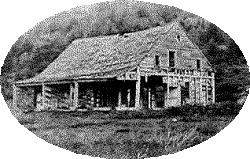"The first efforts to settle the Fulton Chain region ended soon after
1803 when one discouraging settler after another wearily headed South
leaving a few clearings to the wolves and the brambles."
Up Old Forge Way by
David H. Beetle, 1948
In 1798, a substantial Providence RI importer named John Brown, sent his son-in-law John Francis to New York City to sell a shipload of cargo from the Orient. John Francis received $200,000 for the goods but fell into the hands of some land traders including Aaron Burr and came back to Providence with a second mortgage to 210,000 acres of property in Northern New York State. As luck would have it, the first mortgage faltered and John Brown, making the best of the situation decided to investigate his holdings. He hired surveyors and laid out a Tract which included eight townships: Industry, Enterprise, Perseverance, Unanimity, Frugality, Sobriety, Regularity and Economy (the future Old Forge). He had a 25-mile wagon road cut through wilderness along an old Indian trail from Remsen and subsidized about 20-30 farmers to move into the Tract. He had a dam and grist mill built at the outlet of Old Forge Pond, but soon discovered this was not a profitable farming area and shortly after his death in 1803, the settlement was abandoned.
John Brown's son-in-law, Charles Frederick Herreshoff, stepped in seven years later. Married to Sarah Brown, he soon discovered his share of the Brown estate would not sustain them in style in Providence, so in 1811 he came with 300 Merino sheep up to Brown's Tract and built a home near the Thendara Railroad Station at the location of the State sandpit on Rt. 28. Later he opened an iron mine back of his house and built a forge near the newly refurbished gristmill near the dam. The mine did not pay, the wolves lapped up the sheep, and in 1819 after a failed attempt to be buried alive in the mine, he wandered up the hill in back of his manor house and shot himself. A few pioneer families stayed on, the Joy's of Joy Tract, the Gibbs at Gibbs Lake, but by 1825 the gristmill and forge were closed and nature again took over.
 Two
remnants remained - the spacious Manor House and the bumpy wagon trail
(still referred to as Brown's Tract Road) to the Moose River Settlement that
Herreshoff cut to replace the Remsen route. From there, one could get a meal
and another wagon to Boonville and then on to Utica.
Two
remnants remained - the spacious Manor House and the bumpy wagon trail
(still referred to as Brown's Tract Road) to the Moose River Settlement that
Herreshoff cut to replace the Remsen route. From there, one could get a meal
and another wagon to Boonville and then on to Utica.
In the 1830's, the "infamous" character Nat Foster and his family moved into the abandoned Herreshoff residence. A crack shot with a double-loaded rifle, Nat was well known among the remnant guides that wandered through the area. A long running feud existed between Nat and a local full-blooded Indian named Peter Waters (known locally as Drid). One day in September 1833, Drid attacked Nat with a knife, wounding his arm. Nat went home to get his gun while Drid and the others paddled up the Chain on a hunting trip. Later in the day on their return trip up the Channel, Nat shot and killed Drid from the shoreline at a place now referred to as Indian Point. Later, Drid's body was brought back to the Dam and buried on the shore of the beach. Two stones marked the site and it was carefully tended by another Native American named Maurice Dennis for many years. With the coming of the railroad in 1892, the gravesite was soon forgotten and obscured by sand. In September of 1941, at the request of Town Supervisor P. W. Burdick, the grave was rediscovered. Assisting in the task were Emmett Marks, a resident since 1872, Wm. Weedmark, Ira Parsons, Phil Christy and Jack and Peter Rivett. Eventually a new marker was placed at the gravesite. Nat Foster stood trial for his crime but was acquitted in a well-publicized trial in Herkimer. He soon left the area and the Herreshoff Manor was abandoned again.
In 1837, Otis Arnold, a struggling Boonville farmer with six children, hiked in to discover the Herreshoff Manor. Without bothering with deeds or titles, the Arnolds moved in for the next thirty-one years. They raised twelve children including ten daughters who were described by early visitors as shy but woodsy. They could thresh grain, chop wood and ride horses with the best of men. Later visitors recalled seeing the girls light fires under the cows to smudge off the black flies. Soon the Arnolds were running a hotel of sorts. Map makers and guidebooks made note of this unusual place and family. Guests were charged $1.50 a day or 11.00 a week. They produced their own wool, hay feed, vegetables, milk and fruits and hauled the surplus back to Boonville. Guided groups came through from the north as well.
One day in 1867, a guide from Indian Lake got into a dispute with Otis over a dog collar. Tempers flared, then a scuffle and finally Otis pulled out his shotgun and killed the guide. Struck with remorse, and fearing arrest, Arnold hiked up to Nick's Lake and drowned himself. By 1880, Mrs. Arnold and the children had dispersed and the building was vacant. But this remarkable family and the hospitality they provided to people drawn to the natural beauty of the rivers, lakes and mountains in the region establish a heritage that continues to charm visitors today. Town of Webb residents still warmly welcome tourists who come to enjoy some of the best recreational opportunities in the Adirondack Park.
Use BACK button to return to previous page or click HOME LINK.